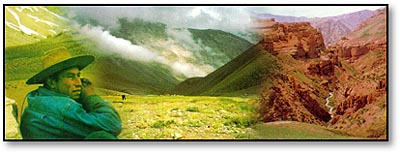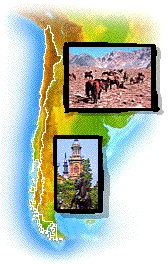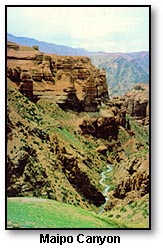
Introduction
 Chile is a country of startling
contrasts and extreme beauty, with attractions ranging from the towering volcanic peaks of
the Andes to the ancient forests of the Lake District. There are a multitude of very good
parks here, and plenty of opportunities for fine adventure travel. Chile is justly famous
as the location of Torres del Paine, considered by many to be the finest nature travel
destinations in all of South America.
Chile is a country of startling
contrasts and extreme beauty, with attractions ranging from the towering volcanic peaks of
the Andes to the ancient forests of the Lake District. There are a multitude of very good
parks here, and plenty of opportunities for fine adventure travel. Chile is justly famous
as the location of Torres del Paine, considered by many to be the finest nature travel
destinations in all of South America.
Location, Geography Climate
For anyone who has ever been fascinated by geography, the long, impossibly thin line of
Chile has always produced a tiny moment of astonishment. Chile stretches over 4,300 km
(2,700 mi) along the southwestern coast of South America, a distance roughly the same as
that from San Francisco to New York, or Edinburgh to Baghdad. At the same time, its width
never exceeds 240 km (150 mi), making the country more than eighteen times longer than its
widest point.
The most obvious factor in Chile's remarkable slenderness is the massive, virtually
impassable wall of the Andes, a mountain range that is still rising and that contains more
than fifty active volcanic peaks. The western border is of course the Pacific Ocean, but
it is a misconception to picture Chile as nothing more than the steep western slope of the
Andean peaks. All along its length Chile is marked by a narrow depression between the
mountains and the sea. To the north the land rises and becomes more arid, until one
reaches the forbidding Atacama Desert, one of the most inhospitable regions on
earth. To the south just the opposite transformation takes place: the land falls
away, and the region between mountains and ocean fades into the baffling archipelagic maze
that terminates in Chilean Patagonia. Chile's southern extremity is marked by Cape Horn, a
treacherous headland surrounded by almost continuously storm-tossed seas and passable only
through the foggy stillness of the Strait of Magellan.
 In the center of the country, however, is a long and expansive river valley,
a five hundred mile corridor occupied in the north by vineyards and great farms and in the
south by primeval forests and enchanting lakes. Santiago, the capital, anchors the
northern and more prosperous section of the central valley. The lush Lake District to the
south, however, is the homeland of Chile's indigenous peoples, the Araucanians.
In the center of the country, however, is a long and expansive river valley,
a five hundred mile corridor occupied in the north by vineyards and great farms and in the
south by primeval forests and enchanting lakes. Santiago, the capital, anchors the
northern and more prosperous section of the central valley. The lush Lake District to the
south, however, is the homeland of Chile's indigenous peoples, the Araucanians.
Also part of Chile are two notable Pacific possessions-the Juan Fernandez Islands and the
famous Easter Island, both of which are administered as national parks. The Juan Fernandez
islands are located about 670 km off the Chilean coast, while Easter Island is situated
3700 km distant.
Chile's climate is as diverse as its geography. Aside from the obviously extreme climatic
conditions of the Andes an the Atacama, however, the country enjoys a comfortable
temperate climate.
Copyright (c) 1998 interKnowledge Corp. All rights reserved.
 .
.